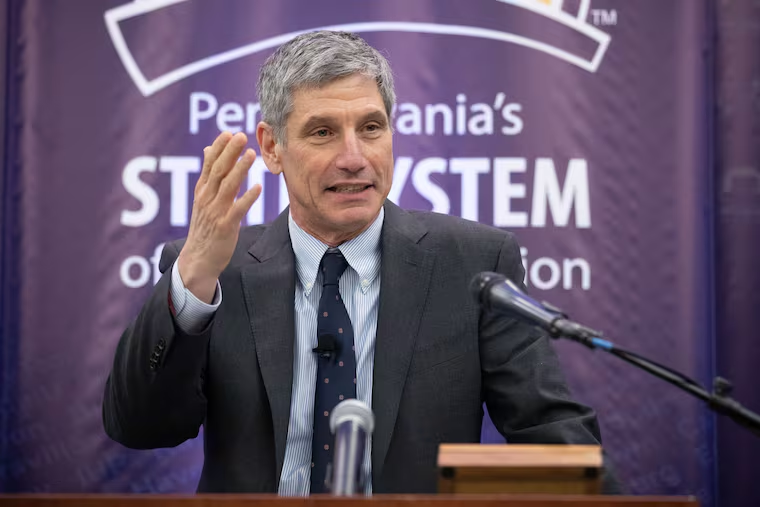Pa. universities freeze tuition for the third straight year
The state system also announces steps to improve diversity of its curriculum and better handle incidents of hate speech and harassment on campuses.

For the third consecutive year, in-state students attending Pennsylvania’s 14 state universities will not face a tuition hike.
The Pennsylvania State System of Higher Education’s board of governors voted Thursday to keep tuition and the technology fee the same, even though it will mean already-strapped schools will have to tighten their belts more.
“It represents real pain for our universities, but the pain for our students is greater,” Chancellor Daniel Greenstein said in an interview before making his recommendation to the board.
» READ MORE: Pa state universities freeze tuition for first time in more than 20 years
In-state students, who make up the vast majority of the system’s 93,000 students, will continue to pay $7,716 in tuition and $478 in fees. Out-of-state tuition is set by the individual campuses.
Several university presidents said that while they supported keeping costs down for students, having no additional tuition funds and possibly no increase in state funding creates a dire situation for schools, which must continue to absorb increases in labor costs. Some presidents had been advocating for a 1% tuition increase, which would mean an additional $82 for students.
“We will have to reduce additional faculty and staff positions as a result and all of us put millions of dollars into institutional financial aid, which will become more challenging to fund because we have less money to give students in need,” said Kenneth S. Hawkinson, president of Kutztown University.
He asked the board of governors to control costs in future contract negotiations with unions because those rising expenses, along with potentially flat state aid, are “really making it next to impossible to do our jobs.”
The other universities in the system are Bloomsburg, Clarion, Cheyney, California, East Stroudsburg, Edinboro, Indiana, Lock Haven, Mansfield, Millersville, Shippensburg, Slippery Rock, and West Chester.
Also at the meeting, Greenstein said the system would be taking steps to improve conditions for students of color, who over the last year have been speaking out about racism on their campuses. The system has recruited more students from underrepresented groups for its campuses but has failed to support them, a Spotlight PA investigation found in August. While the system’s percentage of minority students has nearly doubled since 2008, their graduation rate is nearly 20 percentage points lower than that of white students, the investigation found.
“It is way past time that we get some tangible results here,” said board member Janet Yeomans, who led a committee that developed a five-year strategic plan on diversity, equity, and inclusion, approved unanimously by the board at its meeting.
The system, Greenstein said, will charge a committee with looking into strengthening student conduct codes in dealing with hate speech and harassment and ask a faculty committee to review and diversify the curriculum. The plan also calls for better recruitment, retention, and promotion of diverse staff.
Asked how the curriculum would be diversified, Denise Pearson, vice chancellor and chief diversity, equity, and inclusion officer, said the effort will look at both course content and teaching methods, ensuring that students of color see themselves in the curriculum. A physics course, for example, would teach about not just white physicists but also those of color, she said.
“The absence of a diverse curriculum is absence of affirming their humanity,” Pearson said.
» READ MORE: Condemn, discuss, repeat
The system also is looking at ways to close achievement gaps between white students and students of color in graduation rates, retention, and other areas and ways to make campuses more welcoming, including training around preventing and reacting to racial harassment, speech, and aggression.
The system will roll out a uniform reporting system for campuses to log hate incidents, Greenstein said. Campuses also are including diversity training for faculty and for students, some in freshman orientation classes and some in freshman studies courses, Pearson said.
State Sen. Art Haywood (D., Philadelphia) called the system’s step “historic” and said he was pleased it was making an effort to “include traditionally excluded Black and Brown students.” At a hearing in October, Haywood had shared stories of racism and discrimination he heard from Black students at state universities and said Greenstein had mishandled the issue. Earlier this month, Haywood held a town hall with university presidents and the chancellor to hear about the diversity and inclusion plans.
“The university students, allies, and I will be engaged in the hard work to bring these plans to life,” he said Thursday after the vote.
Outgoing Shippensburg University president Laurie Carter said another area that must be addressed is the makeup of councils of trustees on the 14 campuses.
“Few of the councils … are diverse,” she said. “This must be addressed.”